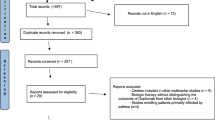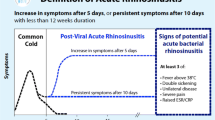Abstract
Chronic rhinosinusitis (CRS) is a chronic inflammatory process of nasal mucosa and paranasal sinuses, lasting more than 12 weeks, without complete resolution of symptoms. CRS is treated medically, followed by Endoscopic sinus surgery (ESS) if necessary, and supplemented by post-operative topical treatment with highly variable clinical outcomes. However, till date there is no consensus on the composition and duration of maximal medical treatment. Despite proven role of topical steroids, the mode of delivery, dose and duration of topical intranasal corticosteroids still remains debatable. Studies found that high volume sinonasal irrigation (> 50 ml) using budesonide is most efficient method but still there is not sufficient data to prove this and results are variable with multiple modifiable factors therefore, this study has been conducted. (1) To determine the difference in mean decrease in Lund-Kennedy endoscopic scores and SNOT-22 scores among post ESS patients with high volume budesonide nasal irrigation nasal cavity and control nasal cavity of chronic rhinosinusitis patients. (2) To determine safety by measuring serum cortisol levels and intra ocular pressure. This is hospital based interventional, randomised, double blind, control trial study. A total of 66 patients of CRS with previous failed medical therapy were included. Same patients nasal cavities were divided into control and case nasal cavities, to avoid demographic bias. All subjects had a baseline SNOT-22 scores (Sino Nasal Outcome Test scores), Lund Kennedy endoscopy score, NCCT PNS score. All patients were undergone ESS procedure. After nasal pack removal, nasal cavities were randomly assigned 1:1 to receive normal saline irrigation (control group) or 1 mg of budesonide irrigation (case group) for transnasal irrigation twice daily for 12 weeks. A total of 66 patients with 132 nasal cavities were included in the study. Out of which 16 were female and 50 were male with mean age 33 year and mean duration of symptoms was 38.19 months. Mean duration of follow up was for 3 months. Mean decrement in SNOT-22 score in control nasal cavity from 52.54(16.309) to 30.06 (18.16) and in endoscopic score from 6.53 (1.33) to 3.93 (1.6) which is statically significant (p value < 0.05) in both scores. Mean decrement in SNOT-22 score in case nasal cavity from 53.73 (15.75) to 21.15 (13.52) and in endoscopic score from 6.74 (1.8) to 2.77 (1.4) which is statically significant (p value < 0.05) in both scores. Decrement in SNOT-22 scores and endoscopy scores in case nasal cavity in comparision to control nasal cavity were compared by student ‘t’ test and found to be statically significant (p value equals to 0.0001). In subjective outcomes 57.57% shows total improvement in control nasal cavities while 72.73% case nasal cavities shows total improvement. Our study shows high volume budesonide irrigation is safe and superior over normal saline irrigation and results were statistically comparable. Still further studies with larger sample size and longer duration of irrigation needed.Based on available evidence, high volume budesonide irrigation is statically safe and superior over normal saline irrigation.


Similar content being viewed by others
References
Fokkens WJ, Lund VJ, Mullol J, Bachert C, Alobid I, Baroody F et al (2012) 2012 European position paper on rhinosinusitis and nasal polyps. Rhinol Suppl. 50:1–298
Timperley D, Schlosser RJ, Harvey RJ (2010) Chronic rhinosinusitis: an education and treatment model. Otolaryngol Head Neck Surg 143(Suppl. 3):S3-8
Glicklich R, Metson R (1995) The health impact of chronic sinusitis inpatients seeking otolaryngologic care. Otolaryngol Head NeckSurg 113:104–109
Mascarenhas JG, Fonseca VM, Chen VG, Itamoto CH, Silva CA, Gregório LC et al (2013) Long-term outcomes of endoscopic sinus surgery for chronic rhinosinusitis with and without nasal polyps. Braz J Otorhinolaryngol 79:306–311
Young LC, Stow NW, Zhou L, Douglas RG (2012) Efficacy of medical therapy in treatment of chronic rhinosinusitis. Allergy Rhinol (Providence) 3:e8-12
Georgalas C, Cornet M, Adriaensen G, Reinartz S, Holland C, Prokopakis E et al (2014) Evidence-based surgery for chronic rhinosi-nusitis with and without nasal polyps. Curr Allergy Asthma Rep 14:427
Snidvongs K, Kalish L, Sacks R, Sivasubramaniam R, Cope D et al (2013) Sinus surgery and delivery method influence the effectiveness of topical corticosteroids for chronic rhinosinusitis: systematic review and meta-analysis. Am J Rhinol Allergy 27:221–233
Kosugi EM, Chen VG, Fonseca VM, Cursino MM, NetoJA M, Gregório LC (2011) Translation cross-cultural adaptation and validation of Sino Nasal Outcome Test (SNOT): 22 to Brazilian Portuguese. Braz J Otorhinolaryngol. 77:663–669
Lund VJ, Kennedy DW (1997) Staging for rhinosinusitis. OtolaryngolNeck Surg 117:S35-40
Gregório LL, Andrade JS, Caparroz FA, Saraceni Neto P, Kosugi EM (2015) Influence of age and gender in the normal values of Sino Nasal Outcome Test-22. Clin Otolaryngol 40:115–120
Rosenfeld RM, Andes D, Bhattacharyya N, Cheung D, Eisenberg S, Ganiats TG et al (2007) Clinical practice guideline: adult sinusitis. Otolaryngol Head Neck Surg 137(3 Suppl):S1–S31
Rudmik L, Hoy M, Schlosser RJ, Harvey RJ, Welch KC, Lund V et al (2013) Topical therapies in the management of chronic rhinosi-nusitis-an evidence-based review with recommendations. IntForum Allergy Rhinol 3:281–298
Snidvongs K, Chaowanapanja P, Aeumjaturapat S, Chusakul S, Praweswararat P (2008) Does nasal irrigation enter paranasal sinusesin chronic rhinosinusitis? Am J Rhinol 22:483–486
Snidvongs K, Kalish L, Sacks R, Craig JC, Harvey RJ (2011) Topical steroid for chronic rhinosinusitis without polyps. Cochrane Database Syst Rev. https://doi.org/10.1002/14651858.CD009274
Kalish L, Snidvongs K, Sivasubramaniam R, Cope D, Harvey RJ (2012) Topical steroids for nasal polyps. Cochrane Database Syst Rev 12:CD006549
Joe SA, Thambi R, Huang J (2008) A systematic review of the use of intranasal steroids in the treatment of chronic rhinosinusitis. Otolaryngol Head Neck Surg 139:340–347
Snidvongs K, Pratt E, Chin D, Sacks R, Earls P, Harvey RJ (2012) Corti-costeroid nasal irrigations after endoscopic sinus surgery in the management of chronic rhinosinusitis. Int Forum Allergy Rhinol 2:415–421
Harvey RJ, Goddard JC, Wise SK, Schlosser RJ (2008) Effects of endoscopic sinus surgery and delivery device on cadaver sinus irrigation. Otolaryngol Head Neck Surg 139:137–142
Grobler A, Weitzel EK, Buele A et al (2008) Pre- and postoperative sinus penetration of nasal irrigation. Laryngoscope 118:2078–2081
Miller TR, Muntz HR, Gilbert ME, Orlandi RR (2004) Comparison of topical medication delivery systems after sinus surgery. Laryngoscope 114:201–204
Wormald P-J, Cain T, Oates L, Hawke L, Wong I (2004) A comparative study of three methods of nasal irrigation. Laryngoscope 114:2224–2227
Abadie WM, McMains KC, Weitzel EK (2011) Irrigation penetration ofnasal delivery systems: a cadaver study. Int Forum Allergy Rhinol 1:46–49
Harvey RJ, Debnath N, Srubiski A, Bleier B, Schlosser RJ (2009) Fluid residuals and drug exposure in nasal irrigation. Otolaryngol Head Neck Surg 141:757–761
Bleier BS, Debnath I, Harvey RJ, Schlosser RJ (2011) Temporospatial quantification of fluorescein-labeled sinonasal irrigation delivery. Int Forum Allergy Rhinol 1:361–365
Thomas WW 3rd, Harvey RJ, Rudmik L, Hwang PH, Schlosser RJ (2013) Distribution of topical agents to the paranasal sinuses: an evidence-based review with recommendations. Int Forum Allergy Rhinol 3:691–703
Harvey R, Hannan SA, Badia L, Scadding G (2007) Nasal saline irrigations for the symptoms of chronic rhinosinusitis. Cochrane Database Syst Rev. https://doi.org/10.1002/14651858.CD006394
Kanowitz SJ, Batra PS, Citardi MJ (2008) Topical budesonide via mucosal atomization device in refractory postoperative chronic rhinosinusitis. Otolaryngol Head Neck Surg 139:131–136
Bhalla RK, Payton K, Wright ED (2008) Safety of budesonide in saline sinonasal irrigations in the management of chronic rhinosinusitis with polyposis: lack of significant adrenal suppression. J Otolaryngol Head Neck Surg 37:821–825
Welch KC, Thaler ER, Doghramji LL, Palmer JN, Chiu AG (2010) The effects of serum and urinary cortisol levels of topical intranasal irrigations with budesonide added to saline in patients with recurrent polyposis after endoscopic sinus surgery. Am J Rhinol Allergy 24:26–28
Sachanandani NS, Piccirillo JF, Kramper MA, Thawley SE, Vlahiotis A (2009) The effect of nasally administered budesonide respules on adrenal cortex function in patients with chronic rhinosinusitis. Arch Otolaryngol Head Neck Surg 135:303–307
Steinke JW, Payne SC, Tessier ME, Borish LO, Han JK, Borish LC (2009) Pilot study of budesonide inhalant suspension irrigations for chronic eosinophilic sinusitis. J Allergy Clin Immunol 124:1352–1447
Nader ME, Abou-Jaoude P, Cabaluna M, Desrosiers M (2010) Using response to a standardized treatment to identify phenotypes for genetic studies of chronic rhinosinusitis. J Otolaryngol Head Neck Surg 39:69–75
Jang DW, Lachanas VA, Segel J, Kountakis SE (2013) Budesonide nasalirrigations in the postoperative management of chronic rhinos-inusitis. Int Forum Allergy Rhinol 3(708–11):24
Kosugi EM, Moussalem GF, Simoes JC, de Paula e Silva Felici de Souza R, Chen VG, Neto PS, Neto JAM (2016) Topical therapy of nasal irrigation with high-volume budesonide solution in difficulty to treat chronic rhinosinusitis. Braz J Otorhinolaryngol 82(2):191–197
Harvey RJ, Schlosser RJ (2009) Local drug delivery. Otolaryngol Clin North Am 42:829–845
Rotenberg BW, Zhang I, Arra I, Payton KB (2011) Postoperative care for Samter’s triad patients undergoing endoscopic sinus surgery:a double-blinded randomized controlled trial. Laryngoscope 121:2702–2705
Smith KA, French G, Mechor B, Rudmik L (2016) Safety of long-term high-volume sinonasal budesonide irrigations for chronic rhinosinusitis. Int Forum Allergy Rhinol 6(3):228–232. https://doi.org/10.1002/alr.21700
Stevens DJ (1988) Cushing’s syndrome due to the abuse of betamethasone nasal drops. J Laryngol Otol 102:219–221
Findlay CA, Macdonald JF, Wallace AM, Geddes N, Donaldson MD (1998) Childhood Cushing’s syndrome induced by betamethasone nose drops, and repeat prescriptions. BMJ 317:739–740
Gill G, Swift A, Jones A, Strain D, Weston P (2001) Severe adrenal suppression by steroid nasal drops. J R Soc Med 94:350–351
Flynn MD, Beasley P, Tooke JE (1992) Adrenal suppression with intranasal betamethasone drops. J LaryngolOtol 106:827–828
Seiberling KA, Chang DF, Nyirady J, Park F, Church CA (2013) Effect of intranasal budesonide irrigations on intraocular pressure. Int Forum Allergy Rhinol 3:704–707
Author information
Authors and Affiliations
Ethics declarations
Conflict of interest
The authors declare that they have no conflicts of interest.
Additional information
Publisher's Note
Springer Nature remains neutral with regard to jurisdictional claims in published maps and institutional affiliations.
Rights and permissions
About this article
Cite this article
Kothiwala, M., Samdani, S., Grover, M. et al. Efficacy of Topical High Volume Budesonide Nasal Irrigation in Post FESS Patients of Chronic Rhinosinusitis With or Without Nasal Polyposis. Indian J Otolaryngol Head Neck Surg 74 (Suppl 2), 1399–1407 (2022). https://doi.org/10.1007/s12070-021-02509-9
Received:
Accepted:
Published:
Issue Date:
DOI: https://doi.org/10.1007/s12070-021-02509-9




